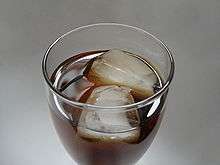Ice cube

An ice cube is a small, roughly cube-shaped piece of ice (frozen water), conventionally used to cool beverages. Ice cubes are sometimes preferred over crushed ice because they melt more slowly; they are standard in mixed drinks that call for ice, in which case the drink is said to be "on the rocks."
Origin

American physician and humanitarian John Gorrie built a refrigerator in 1844 with the purpose of cooling air. His refrigerator produced ice which he hung from the ceiling in a basin. Gorrie can be considered the creator of ice cubes, but his aim was not to cool drinks: he used the ice to lower the ambient room temperature. During his time, a dominant idea was that bad air quality caused disease. Therefore, in order to help treat sickness, he pushed for the draining of swamps and the cooling of sickrooms.
Methods of production
Ice cubes are produced domestically by filling an ice cube tray with water and placing it in a freezer. Many freezers also come equipped with an icemaker, which produces ice cubes automatically and stores them in a bin from which they can be dispensed directly into a glass.
Ice cube tray


Ice cube trays are designed to be filled with water, then placed in a freezer until the water freezes to ice, producing ice cubes. Trays are often flexible, so the frozen cubes can be easily removed by flexing the tray. "Twist" ice trays have a simple spring-loaded mechanism with a lever that is used to turn the tray upside down and flex at the same time such that the cubes drop are collected in a removable tray below and return the ice cube tray to its upright position without removing it from the freezer, which can save time and reduces accidents and mess, though the tray has to be removed to be collected and the ice cube tray still has to be removed to be refilled. An alternative system is an aluminium tray with a lever that raises the ice cubes, freeing them from the tray. A motorized version of this is found in most automatic ice-making freezers.
While the usual shape of the ice 'cube' is roughly cubical, there are trays that dispense hemispherical or cylindrical blocks. These are commonly referred to as "ice tubes". Some novelty trays produce blocks of ice in seasonal, festive or other shapes. There is also the possibility to freeze different edible items inside the ice cubes, both at home and commercial production.
The first rubber ice cube tray was invented by Lloyd Groff Copeman. One day in 1928, while walking through some woods collecting sap for maple syrup, Copeman noticed that slush and ice flaked off his rubber boots rather than adhering to them. Having recalled this incident over lunch with his patent attorney, he conducted experiments using rubber cups. Later, he set about designing and then patenting different types of tray: a metal tray with rubber separators, a metal tray with individual rubber cups which was invented in 1933, and a tray made completely of rubber.[1]
The first flexible stainless steel, all-metal ice cube tray was created by Guy L. Tinkham in 1933. The tray bent sideways to remove the ice cubes. At the time he was the President of a company that sold and produced household products.
Several companies now offer pre-filled disposable ice trays for home freezing, which they claim provide better taste and reduced risk of contamination.[2]
Large-scale ice cube production
Dedicated ice-maker machines can be used to produce ice cubes for laboratories and academic use. Ice cubes are also produced commercially and sold in bulk; these ice cubes, despite their name, are often cylindrical, and may have holes through the center.
Clear ice cubes
An interesting characteristic of commercially made ice cubes is that they are completely clear, lacking the clouding found in the center of domestically made ice cubes. Cloudy ice cubes result when water is frozen quickly, or when the water is high in dissolved solids. When water is cooled to its freezing point, and ice starts to form, dissolved gases can no longer stay in solution and come out as microscopic bubbles. However, as ice floats in water, once there is enough ice to form a layer on the surface, the ice layer traps all bubbles within the ice cube. Commercial ice-makers use a flowing source of purified water to make ice with cooling elements at the bottom, allowing the bubbles to be washed away from the top as the cube grows.
Crushed ice
Ice cubes that are crushed or sheared into irregularly-shaped flakes may add an interesting aesthetic effect to some cocktails. Crushed ice is also used when faster cooling is desired, since the rate of cooling is governed by the number and average radius of the ice particles. Ice is often also crushed to form 'slushies', which can be both alcoholic and non alcoholic. [3]
See also
References
| Wikimedia Commons has media related to Ice cubes. |
- ↑ "www.lloydcopeman.com: Biography" (PDF).
- ↑ "After Bottled Water? Purified Ice Cubes". Retrieved 2008-06-03.
- ↑ Rauch, Jeffrey (1975). "The mathematical theory of crushed ice". Partial differential equations and related topics (Program, Tulane Univ., New Orleans, La., 1974). Berlin, New York (the state): Springer-Verlag. pp. 370–379. MR 0427863.
